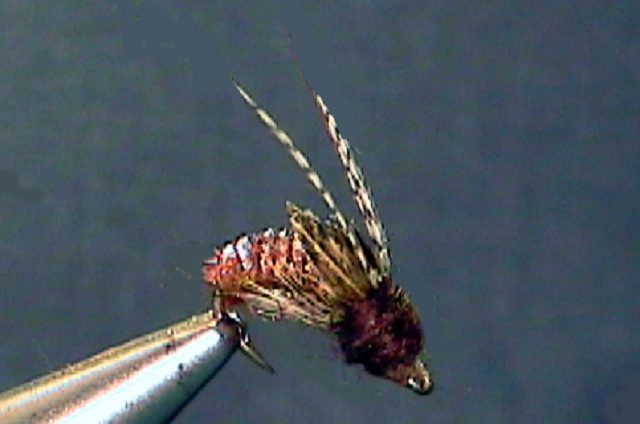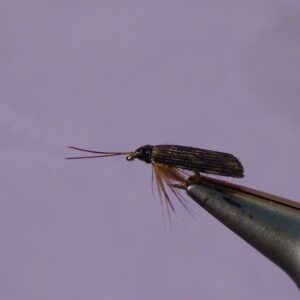Hook Size: 16/18
that of a typical mayfly hatch in that respect. That is one thing that makes this
hatch important to anglers. These caddisflies don’t usually hatch in shallow water
or near the edge of a stream like many aquatic do. They usually hatch
mid-stream and by that I mean anywhere out in the stream.
The Little Black Caddisfly (Mothers Day) hatch usually starts in the early
afternoon and can last until late afternoon. Often the hatch is still underway when
the female adults begin to deposit their eggs on the surface. This usually occurs
later in the afternoon and can add activity to the point it becomes a feeding
frenzy.
I have read that the pupae swim to the surface using their middle legs aided by
air bubbles. I have not been able to actually observe this even though I have
raised them in an aquarium. I will have to accept others word that this is how the
pupae manage to get to the surface. They hatch in the surface skim by shedding
their thin pupa skin and drying their wings. They then proceed to fly away to the
stream side bushes, trees or grass.
It is during the time that the pupae are accenting to the surface and changing
into an adult fly that the trout feed on them the most. I have seen this many times
in many different streams in the West. The trout will just flash or swirl beneath the
surface when they are taking the pupae. Sometimes you can see the surface
disturbance and sometimes you cannot. It depends on the particular type of
water. I believe that far more pupae are eaten by trout that newly hatched adults.
This is certainly a stage of the hatch you want to be able to imitate.
Pupae Presentation:
The pupae usually hatch in water that is relatively smooth even in streams that
consist mostly of fast moving pocket water. They seek the slower, smoother
areas of the stream, such as the pockets behind rocks, to emerge. If you are
fishing pocket water, then I would suggest you use an across stream
presentation of the pupae imitation.
Under these conditions, you can get much closer to the feeding trout fishing
upstream. In smooth flowing streams you may be better off using a down and
across presentation. It can be difficult to get very close to the feeding trout in
smooth flowing water.
With either type of presentation, across stream or downstream, you want to
imitate the pupa swimming to the surface to hatch. You do that by simply
stopping the rod near the end of the drift and allowing the fly to rise back up to
the surface. The current will bring the fly back to the surface for you.
Many Rivers have sections of fast moving pocket water and large, smooth flowing
sections of water depending on the particular part of the stream you are fishing.
The Little Black Caddis hatch can be affected by spring runoff on some western
trout stream. Heavy early season rains can become a problem some years for
some eastern and mid-western trout streams but all in all, it is certainly the most
important early season caddisfly hatch and sometimes one of the most important
hatches there are.

